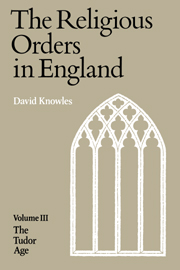Book contents
- Frontmatter
- Contents
- Preface
- List of Abbreviations
- Part One The Tudor Scene
- Chap. I The reign of Henry VII
- Chap. II Some monastic activities
- Chap. III The Cistercians
- Chap. IV The Premonstratensians
- Chap. V The friars in the early sixteenth century
- Chap. VI Sixteenth-century visitations
- Chap. VII Monastic personalities
- Chap. VIII Humanism at Evesham
- Chap. IX William More, prior of Worcester, 1518–36
- Chap. X Butley and Durham
- Part Two The Gathering Storm
- Part Three Suppression and Dissolution
- Part Four Reaction and Survival
- Appendix I Sir Thomas More's letter ‘to a monk’
- Appendix II Religious houses suppressed by Cardinal Wolsey
- Appendix III The witness of the Carthusians
- Appendix IV Houses with incomes exceeding £1000 in the Valor Ecclesiasticus
- Appendix V The sacrist of Beauvale
- Appendix VI Itinerary of the visitors, 1535–6
- Appendix VII The commissioners for the survey of the Lesser Houses in 1536
- Appendix VIII The conflict of evidence on the monasteries
- Appendix IX The last abbots of Colchester, Reading and Glastonbury
- Appendix X Regulars as bishops
- Bibliography
- Index
Chap. II - Some monastic activities
Published online by Cambridge University Press: 08 January 2010
- Frontmatter
- Contents
- Preface
- List of Abbreviations
- Part One The Tudor Scene
- Chap. I The reign of Henry VII
- Chap. II Some monastic activities
- Chap. III The Cistercians
- Chap. IV The Premonstratensians
- Chap. V The friars in the early sixteenth century
- Chap. VI Sixteenth-century visitations
- Chap. VII Monastic personalities
- Chap. VIII Humanism at Evesham
- Chap. IX William More, prior of Worcester, 1518–36
- Chap. X Butley and Durham
- Part Two The Gathering Storm
- Part Three Suppression and Dissolution
- Part Four Reaction and Survival
- Appendix I Sir Thomas More's letter ‘to a monk’
- Appendix II Religious houses suppressed by Cardinal Wolsey
- Appendix III The witness of the Carthusians
- Appendix IV Houses with incomes exceeding £1000 in the Valor Ecclesiasticus
- Appendix V The sacrist of Beauvale
- Appendix VI Itinerary of the visitors, 1535–6
- Appendix VII The commissioners for the survey of the Lesser Houses in 1536
- Appendix VIII The conflict of evidence on the monasteries
- Appendix IX The last abbots of Colchester, Reading and Glastonbury
- Appendix X Regulars as bishops
- Bibliography
- Index
Summary
MUSIC AND THE CHANT
In an earlier volume some account was given of the development of Gregorian chant and other music in the monasteries of England down to the beginning of the thirteenth century, and the story was continued later with a few notes upon the thirteenth and fourteenth centuries. Until very recently little was known of English music between 1350 and 1500, when the series of great composers began, whose Masses and motets opened what now for sixty years has been recognized as the golden age of English music. Within the last thirty years or so, however, musicologists in Europe and America have revealed with increasing clarity the eminence of the Englishman John Dunstable (d. 1453), and his importance in the history of continental as well as of English music. Between Dunstable and the sixteenth century something of a void seemed to exist, and it had been suggested that, as with poetry and literary prose an interlunary period had succeeded the age of Rolle, Hilton, Langland and Chaucer, so in music no master had immediately followed Dunstable. Now, however, a group of scholars can show this supposition to be false; throughout the fifteenth century music of a very high order of excellence was being produced, which set England in the van of a great movement and led without a break from Dunstable to the masterpieces of Taverner and Byrd, and through the age of the madrigalists to that of Henry Purcell.
- Type
- Chapter
- Information
- The Religious Orders in England , pp. 15 - 27Publisher: Cambridge University PressPrint publication year: 1979



